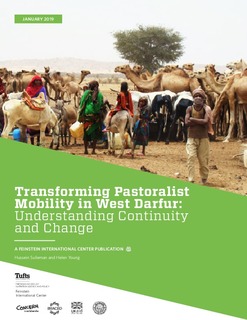Transforming Pastoralist Mobility in West Darfur: Understanding Continuity and Change
Research report

Permanent lenke
http://hdl.handle.net/11250/2585306Utgivelsesdato
2019-01-01Metadata
Vis full innførselSamlinger
- Publications [1488]
Originalversjon
A Feinstein International Center publication, January 2019Sammendrag
In the Darfur Region of Sudan, patterns of livestock mobility and livelihood systems are continually adapting and transforming themselves in the face of multiple challenges. Earlier studies have shown that pastoralist mobility offers significant production advantages and enables pastoralist herds to access the best-quality grazing during the rainy season as they selectively target the new, more nutritious growth. Mobility also allows pastoralists to minimize time spent in difficult conditions (mud, flies, and overcrowding or overgrazing), while also maintaining dry season pasture and fodder reserves. Some of the challenges to livestock production are well known and documented. However, little is known about how livestock keepers cope with and manage extreme climate variability, and potential insecurity and conflict, and how this coping differs according to systems of livestock production and mobility patterns. In 2017, we undertook a study to improve our knowledge of these factors in West Darfur, Sudan. Using Global Positioning System (GPS) tracking devices, we tracked livestock herds (sheep, cattle, and camel) of 13 livestock keepers for six months, from April to September 2017. The herds came from two areas in West Darfur: El Geneina Locality (Telehaya) and Kulbus Locality (Goshosh and Bir Taweel). We used the GPS data to produce maps illustrating the movements of each herd during part of the hot dry season (seif), the rainy season (kharif), and the pre-harvest and harvest period (deret). These are the seasons when interaction between herders and farmers are most active. The maps allow a comparative analysis by season, by livestock species, and by pattern of mobility (distant, close, or sedentary). The annual cycle of mobility differs according to whether livestock keepers are specialists in farming (Goshosh and Bir Taweel communities) or in pastoralism (Telehaya community). The traditional livestock corridors (murhal) linking the rainy season grazing areas